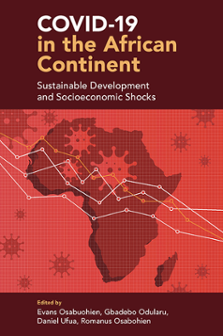
Index
COVID-19 in the African Continent
ISBN: 978-1-80117-687-3, eISBN: 978-1-80117-686-6
Publication date: 23 May 2022
Citation
(2022), "Index", Osabuohien, E., Odularu, G., Ufua, D. and Osabohien, R. (Ed.) COVID-19 in the African Continent, Emerald Publishing Limited, Leeds, pp. 357-371. https://doi.org/10.1108/978-1-80117-686-620221034
Publisher
:Emerald Publishing Limited
Copyright © 2022 Evans Osabuohien, Gbadebo Odularu, Daniel Ufua, and Romanus Osabohien. Published under exclusive licence by Emerald Publishing Limited
INDEX
- Prelims
- Introduction
- Section I COVID-19, Socioeconomic Shocks and Development in Africa
- Chapter 1 Social Protection Responsive Measures to Mitigate Adverse Socioeconomic Effects of COVID-19 in Southern Africa
- Chapter 2 Broad Effects of the Legal System in Addressing the Socio-Economic Shocks in Africa
- Chapter 3 Insecurity during COVID-19 Pandemic: Policy Gaps and Prospects for Inclusive Security Outfits in Nigeria
- Chapter 4 Impact of FDI and Trade on African Economies: Developing Neural Network Feedforward Structure for a COVID-19 Scenario
- Chapter 5 Socioeconomic Shocks and Value Chain Development of Tomato in Kano, Nigeria
- Section II Performance of Africa's Health and Educational Sectors in the ‘New Normal’
- Chapter 6 Artisans' Disposition and Adherence to Preventive Measures of Coronavirus Disease in Osun State, Nigeria
- Chapter 7 Public Health Communication and Response to COVID-19: Resilience among Breastfeeding Mothers in Gqeberha, South Africa
- Chapter 8 Gender and COVID-19 Response Strategy in Africa: The Nigerian Case
- Chapter 9 COVID-19 and Entrepreneurship in Nigeria: Embedded Opportunities and Challenges
- Section III Sectoral Development and Trade in Post-COVID-19 Africa
- Chapter 10 Finance Schemes and Small Business Development in Nigeria
- Chapter 11 Palm Oil Price Fluctuations and Welfare in Nigeria
- Chapter 12 How Economic Growth in Africa Responds to Chinese Loans: Evidence from New CARI's Loan Dataset
- Chapter 13 COVID-19: Dynamics of Socio-Economic Shocks on Energy Sector Performance in Africa
- Chapter 14 COVID-19 Impact on Small and Medium Scale Agro-Allied Manufacturing Enterprises in Southwest Nigeria
- Section IV Post-COVID Economic Resilience and Development in Africa
- Chapter 15 Household Conflict and COVID-19 Lockdown: Conceptual Reflection from Nigeria
- Chapter 16 Policy Implications of IMF and World Bank Loans towards COVID-19 Economic Crisis on African's Development
- Chapter 17 Edible Backyards: A Study of Household Food Security during COVID-19 Pandemic in Nigeria
- Chapter 18 Exploring the Unintended Consequences of COVID-19 Pandemic on Achieving Smart Cities in Africa
- Section V Services and Sustainable Development in Post-COVID-19 Africa
- Chapter 19 Exploring the Experiences of Social and Auxiliary Workers during COVID-19 Crisis in South Africa
- Chapter 20 Post-COVID-19 and African Agenda for a Green Recovery: Lessons from the European Union and the United States of America
- Chapter 21 Financial Effects of COVID-19 Pandemic on the Nigerian Tourism Industry: Policy Implications
- Chapter 22 Cashless Policy Instruments and Financial Transactions in Lagos, Nigeria
- Conclusion: COVID-19 and Pandemic Preparedness in a Digital Age
- Index